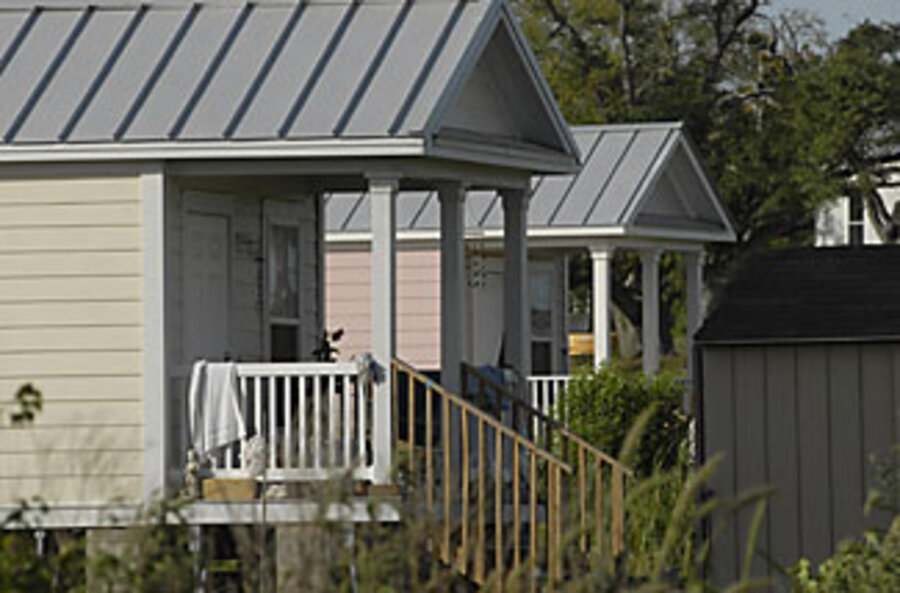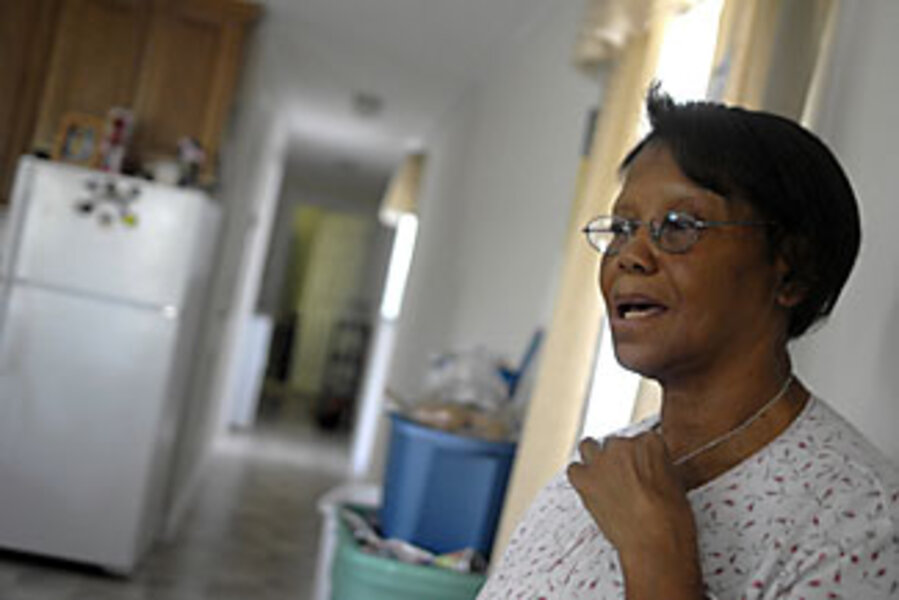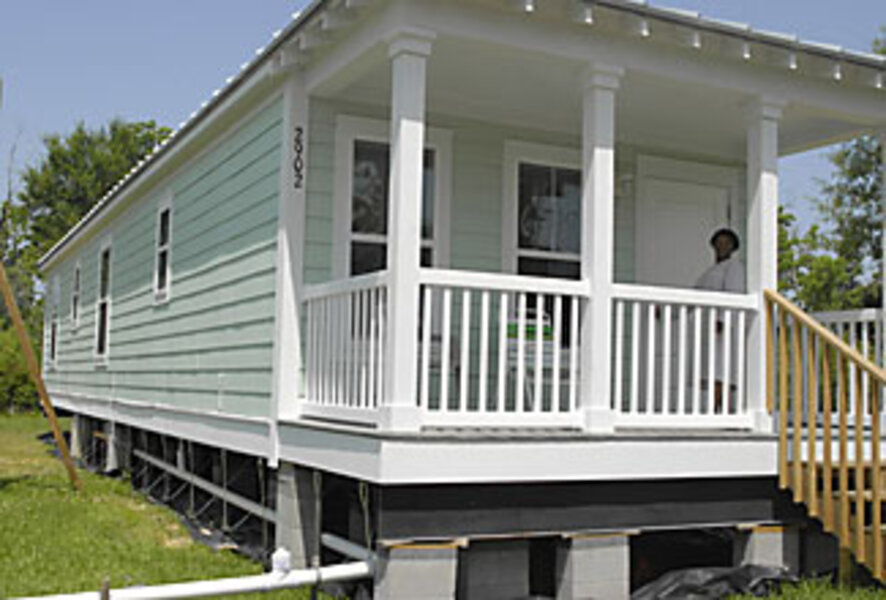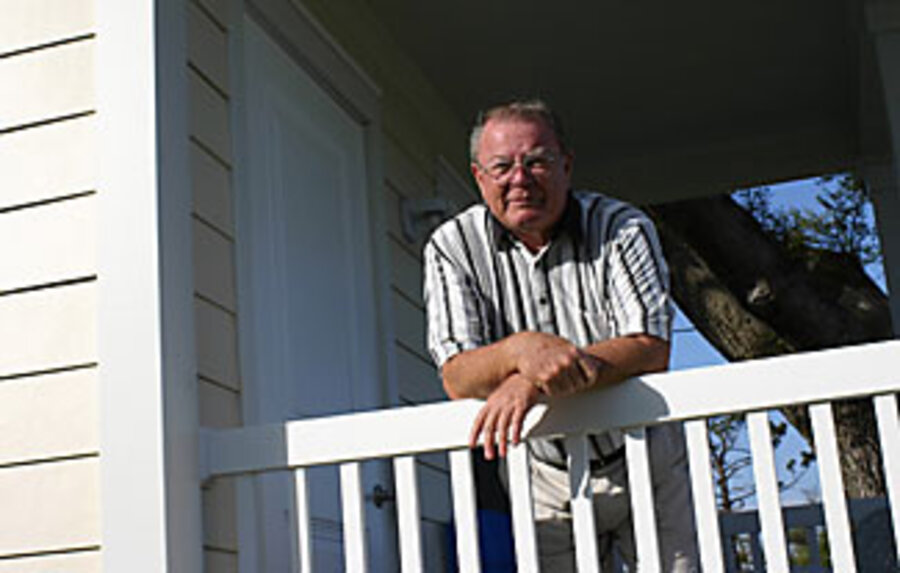Cottages are lightning rod in storm over Gulf's future look
Loading...
| WAVELAND, Miss.
Russell Voorhies loved his 3,000-square-foot house on the Mississippi Gulf – the way the porch snagged the winds, the big rooms echoing with the laughter of company.
Hurricane Katrina downsized his domain to nothing. Today, his new castle is about one-seventh the size of his old one, measuring 450 square feet. But surveying the familiar view from the dollhouse porch of his "Mississippi cottage," Mr. Voorhies is one of many storm survivors who have reassessed their coastal existence.
"Small works for me right now," Voorhies says of his cottage, one of nearly 2,400 the Mississippi Emergency Management Agency (MEMA) has given to state residents to replace the FEMA trailer. "There's less to lose."
Not everyone is an enthusiast of the Mississippi cottage – a wheeled version of the now famous Katrina Cottage – despite its compact cuteness. Most communities along the now-rebuilding Gulf Coast have demanded that MEMA haul them out by next March, citing concerns about their storm-worthiness, low assessed values, and aesthetics. That is leading some cottage-dwellers to vow to fight for their abodes, promising a showdown ahead.
The outcome will determine whether the Mississippi cottage fades away or becomes an architectural cornerstone of the rebuilt coast. Cottage champions warn that their removal may force another exodus of low-income Katrina survivors. Cottage detractors say their narrow profiles are too reminiscent of the post-Katrina trailer era – daily reminders of the havoc and sorrow of that time.
Some see in the cottage controversy a battle brewing between two visions for the Mississippi Gulf Coast. On one side are neotraditionalists who want the region to embrace the tenets of New Urbanism, rebuilding denser, walkable communities on higher ground and using architectural details borrowed from New Orleans and the Old South. On the other are traditionalists who want the region returned to its former glory – to be, as much as possible, as it was before, but safer.
"This is one of the first times in recent history when a populated place has become displaced in this way followed by a massive effort to figure out the solution in a thoughtful and careful way," says Brian Wright, a New Urbanist planner based in Nashville, Tenn., who has worked on the post-Katrina Gulf. "What's challenging is to remember that while there's no building there now, the ghost of that building is still in place and people can still see it."
With the Mississippi cottages as the flash point, various communities are in the throes of defining their identities. One is Pass Christian, a town of 3,000 whose name became known nationwide for the terrible blow it took from Katrina. The town lost a third of its beachfront mansions in the storm. It is one of the communities that expects the cottages to be gone by March.
"There's a desire by citizens here to not change the character of the city too much [from prestorm days], and even though they sympathize with a person's plight, do you want your town dominated by little cottages?" says Lou Rizzardi, a city alderman. "If you look at it from the tax base, the character of the town, livability, appearance, the question is: What do we owe it to people to try to accommodate them? How far backwards do we bend? We're seeing a whole change of character, a change of lifestyle, and that is extremely difficult for many people to accept."
Those are difficult questions, made harder by the fact that, since the storm, living costs have doubled and construction costs have nearly tripled throughout the region. It doesn't help that many cottage residents, uncertain whether their domiciles will be staying or going, are treating them as trailers – no pictures on the walls, bare porches, no landscaping.
But the deeper question is whether the state should subsidize, in the form of cottage handouts furnished with everything from bathroom towels to silverware, those people who now can't afford to rebuild on the pre-Katrina scale.
Janet Densmore, a Pass Christian artist, says the storm's destruction inspired a "values shift" along the coast, where residents now take greater pleasure in the small and mundane aspects of life than they did before Katrina. Whether that shift endures or gives way to another ethic, such as one that emphasizes rapid growth and upward mobility, will help determine the Gulf's future aesthetics.
As recovery began in late 2005, storm-shocked residents flocked to local planning sessions known as "charettes," where they spent days on end envisioning the rebirth of their communities. Since then, most coastal cities in Mississippi have adopted some version of the Smart Code, a zoning guide that encourages what proponents call "urbanized development" – apartments situated over shops, for example – instead of the sprawl-promoting suburban zoning that came into vogue in the 20th century. Last month, Gulfport gave the go-ahead to a downtown project designed by Andrés Duany, a Miami-based architect and the "guru in chief" of New Urbanism.
Smart Code proponents there want to see a centralized city center that's built on higher ground, saying adherence to the code will better protect life and property in the event of another Category 3 storm. They see no reason why the cottages – which can be moved to permanent, even raised, foundations – couldn't become a cornerstone of that vision.
"I've had conversations with people who said they love being on the Gulf Coast, but they're nervous about coming back and building a huge house," says Marianne Cusato, the Florida-based architect who designed the Katrina Cottage. "Right now, people don't know how to reinvest. And that's not just money re-investing, but mental reinvesting. With a smaller house, they can move in, be comfortable, and really see where it goes."
The antithesis of the showy mansions that formerly dominated the Gulf beachfront, the Mississippi cottages nonetheless are reminiscent of the earliest forms of housing on the storm-prone coast, historians say.
"All the the other styles of houses we have developed from need, and this is a clear and obvious need," says Bay St. Louis historian Charles Gray. "The need now is for a comfortable, secure, climate-controllable house, and these little Creole or Mississippi cottages are all very suitable for that."
That sense of comfort is sustaining residents such as Loretta Flowers of Gulfport. To her, the cottage has become a lifeline to the property where her house once stood. She can't afford to rebuild on her own, and the lines are long at the volunteer centers that still provide free labor and some free materials to displaced families, she says. But like many others who remain in the cottages or in trailers from the Federal Emergency Management Agency, the option of leaving the Gulf is not one she's willing to consider.
"I'm just praying that I will get a home built, but so far hasn't anything happened," says Ms. Flowers. "This cottage is the best thing I have now. But this is my land and I'm going to be here, right here."
East of Gulfport, in Biloxi, city officials are reconsidering the March deadline for cottage removal, as a growing number of residents say they want to buy the cottages from the state and keep them as residences or guest houses. If Biloxi lets the cottages stay, that's likely to put pressure on towns up and down the coast to do the same, experts say.
MEMA, meanwhile, promises that the cottages can be moved to permanent foundations. The last thing the state wants is to mothball a huge inventory of used cottages, which cost $40,000 apiece. "MEMA is calling towns frantically, saying, 'What are we going to do with 4,000 cottages we've got to get rid of?' " says Jeff Bounds, an adviser to Pass Christian's rebuilding effort.
The cottage debate has laid bare a poignant fact about the nature of Mississippi's recovery: Real progress toward fortifying the coast depends in large part on residents and civic leaders overcoming nostalgia for what used to be.
"Common sense says we should build stronger than some of what we're seeing now," says Mr. Rizzardi, the Pass Christian alderman, speaking of new construction in general. "There are a number of structures that barely meet the [building] code, but you come to a point where you say, what do we have to require, what's fair?"
For Russell Voorhies in Waveland, fair means that officials will accept his cottage as more than a set of temporary walls. The tiny house represents enough of a future that he says he's willing to fight for his option to buy it and keep it on his beachfront lot.
"This is home now," he says. "At least it's the same view as before."
• Mark Thomson contributed reporting.









